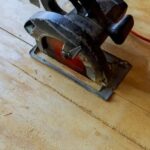Removing water-based paint from woodwork is an essential task for maintaining the beauty and integrity of your wooden surfaces. Whether it’s accidental spills, drips, or the need to repaint, knowing how to effectively remove water-based paint is crucial in preserving the quality and appearance of your woodwork.
Water-based paint, unlike oil-based counterparts, has become a popular choice due to its ease of use, quick drying time, and low odor. However, if not properly removed, it can cause long-term damage to your woodwork. The chemicals in water-based paint can penetrate the pores of the wood and lead to discoloration, swelling, or even warping over time.
In this article, we will provide you with a comprehensive guide on how to remove water-based paint from woodwork. From understanding the nature of water-based paint and its effects on wood to step-by-step instructions for removing the paint without damaging the surface – we have got you covered. Additionally, we will explore alternative methods and products for those who prefer different approaches. So let’s get started on restoring your woodwork back to its original beauty.
Understanding the Nature of Water Based Paint and its Effects on Woodwork
Water based paint is a popular choice for many homeowners and DIY enthusiasts due to its ease of use, quick drying time, and low odor. However, it is important to understand the nature of water based paint and how it can affect woodwork before attempting to remove it.
Water based paint is made up of pigment particles suspended in water, with the water acting as a binder. This type of paint forms a durable film on surfaces when it dries. When applied to woodwork, water based paint penetrates into the surface and creates a protective layer that can enhance the appearance of the wood while also protecting it from damage.
While water based paint offers many benefits, it is not without its drawbacks when it comes to woodwork. Over time, exposure to sunlight and moisture can cause the paint film to degrade or crack, leading to peeling or flaking. Additionally, improper application or poor surface preparation can result in adhesion issues and uneven drying. Understanding these potential effects will help you choose the appropriate method for removing water based paint from your woodwork.
| Effect | Data |
|---|---|
| Peeling and cracking | Inadequate surface preparation can lead to peeling and cracking of the paint film. |
| Flaking | Exposure to sunlight and moisture over time can cause the paint film to degrade or crack, resulting in flaking. |
| Adhesion issues | Poor application techniques or contamination on the surface can lead to adhesion problems where the paint does not properly bond to the woodwork. |
| Uneven drying | If the paint is applied too thickly or in humid conditions, it may dry unevenly and result in a blotchy appearance. |
Preparing the Tools and Materials Needed for Removing Water Based Paint from Woodwork
Before you begin the process of removing water based paint from woodwork, it is important to gather all the necessary tools and materials. Having everything prepared beforehand will ensure a smooth and efficient paint removal process. Here is a list of items you will need:
- Protective Gear: It is crucial to prioritize your safety during any paint removal project. Wear gloves, safety glasses, and a face mask to protect yourself from potentially harmful fumes or chemicals.
- Drop Cloth or Plastic Sheet: Lay down a drop cloth or plastic sheet to protect the surrounding area from any paint chips or debris that may fall during the removal process.
- Paint Scraper: A good quality paint scraper with a sharp edge will be essential for effectively removing water based paint from woodwork. Choose one that has multiple edges or replaceable blades for better results.
- Sandpaper: Depending on the condition of the woodwork and the amount of paint residue left after scraping, you may need sandpaper to smoothen out any rough patches. Select different grits of sandpaper, starting with coarse grit for heavy paint build-up and finishing with fine grit for a polished finish.
- Denatured Alcohol: Considered an effective solvent for water based paints, denatured alcohol can help break down and remove stubborn paint stains on woodwork without causing damage. Make sure to choose denatured alcohol specifically labeled for use as a cleaning solvent.
- Clean Rags or Cotton Balls: These will be used in conjunction with denatured alcohol to wipe away excess paint residue or clean hard-to-reach areas.
- Bucket of Soapy Water: Prepare a bucket filled with warm soapy water using mild dish detergent or liquid soap. This will be used for general cleaning before and after the removal process.
- Paintbrushes: Keep some disposable brushes handy if you plan to use alternative methods or chemical paint strippers for removing water based paint from woodwork.
By gathering these essential tools and materials beforehand, you will be well-prepared to tackle the task of removing water based paint from your woodwork effectively. Remember to work in a well-ventilated area and follow the safety instructions provided with any chemicals or products used during the process.
Step-by-Step Guide
Removing water-based paint from woodwork can be a daunting task, but with the right tools and techniques, it can be achieved efficiently. This step-by-step guide will walk you through the process of removing water-based paint from woodwork, ensuring that you preserve the beauty and integrity of your wooden surfaces.
Gather the Necessary Tools and Materials
Before you begin, make sure you have all the required tools and materials on hand. You will need:
- A putty knife or a plastic scraper.
- Paint stripping gel or liquid paint remover.
- Paintbrush or old toothbrush.
- Denatured alcohol or mineral spirits.
- Clean rags or paper towels.
- Sandpaper (medium-grit and fine-grit).
- Wood cleaner or soap and water solution.
It is crucial to collect these items beforehand to avoid any interruptions during the paint removal process.
Preparation
Start by preparing the work area. Lay down a drop cloth to protect flooring and surrounding furniture from any potential damage. Open windows for proper ventilation as some paint removers can emit strong odors.
Next, sand the painted surface lightly using medium-grit sandpaper. This step helps in breaking up the top layer of the paint, making it easier for the paint remover to penetrate.
Apply Paint Remover
Using a brush or an old toothbrush, apply a generous amount of paint stripping gel or liquid remover onto the painted area. Ensure that an even layer is applied, covering all parts that need paint removal.
Leave the product on for a sufficient amount of time according to the manufacturer’s instructions. Usually, this ranges from 15 minutes to an hour depending on the type of paint remover used.
Once enough time has passed, test a small area with a putty knife or plastic scraper to check if the paint is loosened enough for removal. If it easily comes off, proceed to the next step. If not, give it more time and retest.
Scrape and Clean
Using a putty knife or plastic scraper, gently scrape away the loosened paint from the woodwork. Work carefully to avoid damaging the wood surface beneath.
After scraping off as much paint as possible, dampen a clean rag or paper towel with denatured alcohol or mineral spirits. Wipe down the area to remove any residual paint or debris. Repeat this process until all traces of paint are removed.
By following these steps diligently, you can successfully remove water-based paint from your woodwork without causing any harm to your wooden surfaces. Remember to take breaks when needed and work in a well-ventilated area for your safety.
Alternative Methods and Products for Removing Water Based Paint from Woodwork
When it comes to removing water based paint from woodwork, there are several alternative methods and products that can be used. These alternatives can be handy when the traditional methods are not yielding the desired results or if you prefer a different approach. Here are some effective alternative methods and products to consider:
- Heat Gun: A heat gun is a powerful tool that can be used to soften and remove water based paint from woodwork. It works by applying heat directly to the painted surface, causing the paint to melt and become easier to scrape off. However, caution should be exercised when using a heat gun as excessive heat can damage the wood surface.
- Chemical Paint Removers: There are various chemical paint removers available in the market that can effectively dissolve water based paint from woodwork. These removers usually come in gel or liquid form and are applied directly to the painted surface. After allowing sufficient time for the remover to work, the softened paint can be scraped off.
- Sanding: If other methods fail or if you prefer a more labor-intensive approach, sanding can also be used to remove water based paint from woodwork. This method involves using sandpaper or a power sander to physically scrub away the paint layer by layer until you reach bare wood. Sanding is a time-consuming process but it provides complete control over the amount of material removed, allowing for precision.
| Method/Product | Description |
|---|---|
| Heat Gun | A powerful tool that applies heat directly to soften and remove water based paint. |
| Chemical Paint Removers | Gel or liquid solutions applied directly to dissolve water based paint. |
| Sanding | Using sandpaper or a power sander to physically scrub away the paint layer by layer. |
These alternative methods and products can be effective in removing water based paint from woodwork, but it is important to carefully consider the nature of your project and the condition of the wood before deciding on a method. It is always recommended to experiment with a small inconspicuous area first and follow the instructions provided by the manufacturer for any chemical products. The goal is to find the method that yields the best results while minimizing damage to the woodwork.
Common Mistakes to Avoid During the Paint Removal Process
Lack of Proper Protection
One of the most common mistakes that people make during the water-based paint removal process is failing to protect themselves and their surroundings adequately. Water-based paints may not be as harmful or toxic as solvent-based ones, but they can still cause skin irritation and respiratory issues if proper precautions are not taken.
It is crucial to wear protective gloves, safety goggles, and a mask to avoid any direct contact with the paint and prevent inhalation of fumes or particles.
Additionally, it is essential to cover furniture, floors, and any other surfaces near the woodwork being treated. This will prevent accidental spills or drips from damaging other items or surfaces in the room. Using drop cloths or plastic sheeting can provide effective protection for your belongings.
Not Testing the Paint Removal Method
Another mistake often made is skipping the step of testing the paint removal method on a small, inconspicuous area before applying it to the entire woodwork. Different types of wood react differently to various removal methods. By testing first, you can ensure that the chosen method does not cause any damage or discoloration to your woodwork.
To test, apply a small amount of your chosen paint remover on a hidden part of the woodwork and wait for a few minutes. Gently scrape off a small section of paint using a scraper. If there are no adverse effects on the wood surface, such as discoloration or warping, you can proceed with confidence knowing that this method is safe for use on your woodwork.
Using Excessive Force
When removing water-based paint from woodwork, it is essential to be patient and avoid using excessive force during the scraping process. Applying too much pressure with a scraper can damage the surface of the wood or leave behind scratches and gouges.
Instead, let your chosen paint remover penetrate the paint layers as per the manufacturer’s instructions. This will allow the paint to soften, making it easier to scrape off gently. Use a gentle back-and-forth motion with the scraper, applying only enough pressure to remove the loosened paint without damaging the wood beneath.
By avoiding these common mistakes during the paint removal process, you can ensure a safe and effective removal of water-based paint from your woodwork while preserving its integrity.
Restoring and Protecting the Woodwork After Removing Water Based Paint
After successfully removing water-based paint from woodwork, it is important to restore and protect the woodwork to ensure its longevity and aesthetic appeal. Restoring the woodwork involves repairing any damage caused during the paint removal process and enhancing its natural beauty. Protecting the woodwork will help prevent future damage, such as stains or scratches. Here are some steps to effectively restore and protect the woodwork:
- Repair any damage: Examine the woodwork for any scratches, dents, or imperfections that may have occurred during the paint removal process. Use wood filler or putty to fill in any gaps or holes, and sand it down until smooth. For deep scratches or gouges, use a woodworking clamp to hold a piece of matching scrap wood against the damaged area while using epoxy glue to bond them together.
- Sand the surface: After repairing any damage, sanding the surface is crucial for achieving a smooth finish. Start with coarse sandpaper (around 120-grit) to remove any remaining paint residue, old finishes, or uneven patches. Gradually move on to finer grits (such as 220-grit) for a smoother finish.
- Apply a protective finish: Once the surface is smooth, apply a protective finish such as varnish, polyurethane, or lacquer to preserve and enhance the appearance of the woodwork. These finishes come in different sheens (e.g., matte, satin, glossy), so choose one that suits your desired look. Apply multiple thin coats rather than one thick coat for better durability.
To maintain and care for your restored woodwork over time:
- Regularly clean the surface with a soft cloth or feather duster to remove dust and debris.
- Avoid placing hot objects directly on the surface as it can cause heat stains.
- Use coasters or mats under glasses and cups to prevent moisture rings.
- Avoid dragging heavy objects across the surface as it can scratch the finish.
- Consider applying a coat of wax or polish annually to maintain the luster of the woodwork.
By following these steps, you can restore and protect your woodwork after removing water-based paint, ensuring its beauty and durability for years to come.
Frequently Asked Questions about Removing Water Based Paint from Woodwork
Removing water-based paint from woodwork can be a challenging task, especially if you are not familiar with the process. To help you navigate through this endeavor, below are some frequently asked questions about removing water-based paint from woodwork.
- Q: Can I use the same method to remove water-based paint from different types of wood?
- A: Yes, the method for removing water-based paint from woodwork is generally the same regardless of the type of wood. However, it is important to consider the condition and quality of the wood before proceeding. Delicate or antique woods may require extra care and caution during the removal process.
- Q: Can I use household items to remove water-based paint?
- A: Yes, there are several household items that can be used to remove water-based paint from woodwork. Commonly used items include vinegar, baking soda, dish soap, and rubbing alcohol. These items are often effective in breaking down the paint and making it easier to remove.
- Q: How long does it typically take to remove water-based paint from woodwork?
- A: The time it takes to remove water-based paint from woodwork can vary depending on several factors including the thickness of the paint layers and the size of the area being treated. On average, it could take anywhere from a few hours to a full day to completely remove the paint. It is important to allocate enough time for each step of the removal process to ensure a thorough job.
By addressing these frequently asked questions about removing water-based paint from woodwork, you will have a better understanding of what to expect and how to approach this task effectively. Remember that patience and attention to detail are key when working on delicate surfaces like woodwork. With proper preparation and execution, you can successfully restore your woodwork to its original beauty.
Conclusion
In conclusion, efficiently removing water-based paint from woodwork requires careful preparation and execution. By understanding the nature of water-based paint and its effects on wood, you can better choose the appropriate tools and materials for the job. Following a step-by-step guide will help ensure successful paint removal without damaging the wood.
While there are alternative methods and products available, it is important to consider their effectiveness and potential risks before using them on your woodwork. It is also crucial to avoid common mistakes that can occur during the paint removal process, such as using excessive force or harsh chemicals that may damage the wood surface.
Once the paint has been successfully removed, it is essential to properly restore and protect the woodwork. This can be done by sanding any remaining residue, applying a suitable wood finish or sealant, and regularly maintaining and cleaning the wood to maintain its beauty and durability.
Frequently Asked Questions
How do you get water-based paint off wood?
To remove water-based paint from wood, there are a few methods you can try. One approach is to use soapy water and a sponge or cloth. Dip the sponge or cloth into the soapy water and gently scrub the painted area in a circular motion. This can help loosen the paint from the wood’s surface.
Another method involves using rubbing alcohol or vinegar. Moisten a cloth with either rubbing alcohol or vinegar and lightly dab it onto the paint, allowing it to sit for a few minutes. Then, using gentle pressure, wipe away the softened paint. If these methods don’t completely remove the paint, you may need to resort to using a chemical paint stripper specifically formulated for water-based paints.
How do you remove dried water-based paint from trim?
Removing dried water-based paint from trim requires a bit more effort, but it’s still possible to achieve good results without damaging the trim surface. Start by scraping off as much of the dried paint as possible using a plastic putty knife or scraper, being careful not to scratch or gouge the trim. Next, soak a cloth in warm soapy water (dish soap works well) and apply it to the remaining paint spots on the trim.
Let it sit for several minutes to soften the paint residue. Then, use a firm bristle brush or an old toothbrush to gently scrub away any loosened paint particles. Repeat this process until all traces of paint are removed.
How do you remove water-based paint from wood without sanding?
If you prefer not to sand your wood in order to remove water-based paint, there are alternative approaches you can take. One option is applying heat with either a hairdryer or heat gun set on low heat setting and carefully directing it towards the painted area. The gentle heat will soften the paint enough for you to scrape it off using a plastic putty knife or scraper without damaging or sanding down the wood surface beneath it.
Another method entails using a commercial chemical stripping agent formulated specifically for removing water-based paints without sanding. Apply the stripping agent according to the manufacturer’s instructions, usually by brushing it on and letting it sit for a specified amount of time before wiping away the dissolved paint. Remember to work in a well-ventilated area and wear appropriate safety gear when using chemical strippers.

Hi everyone! I’m a woodworker and blogger, and this is my woodworking blog. In my blog, I share tips and tricks for woodworkers of all skill levels, as well as project ideas that you can try yourself.





